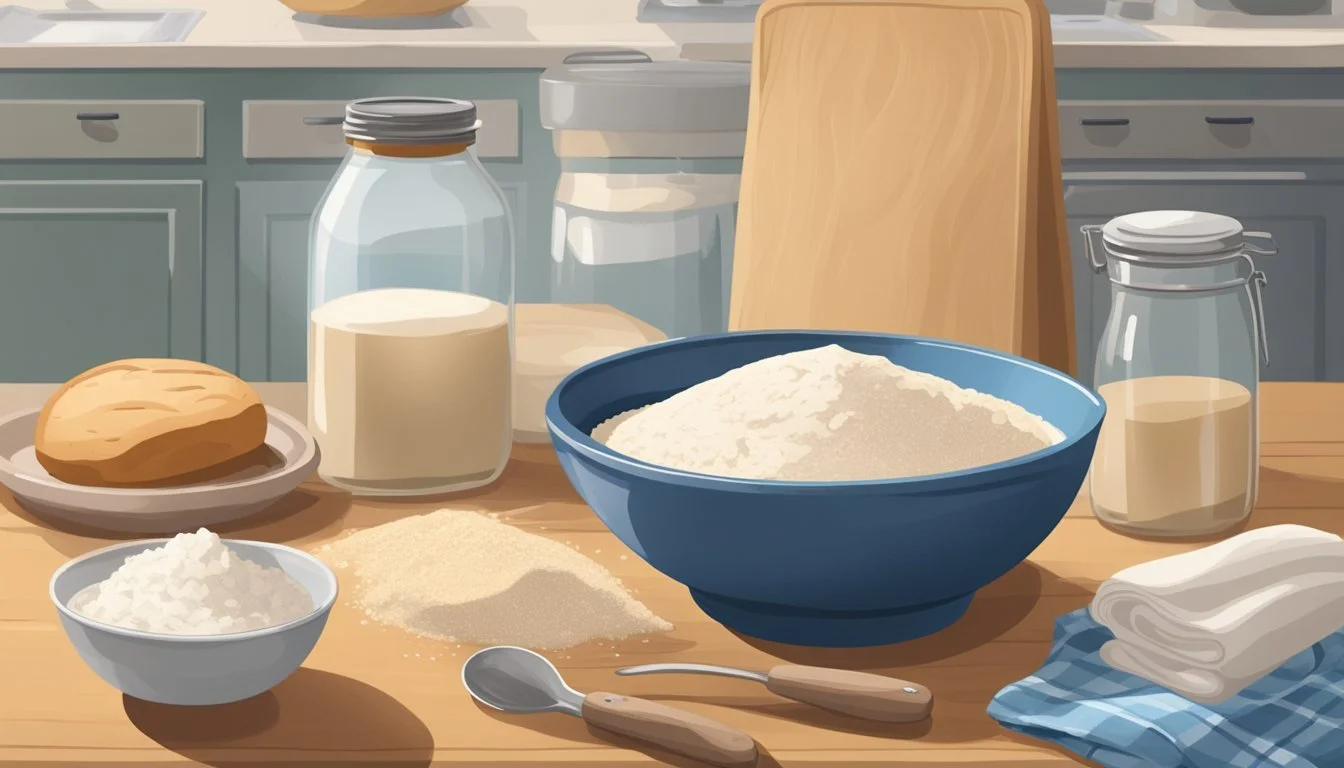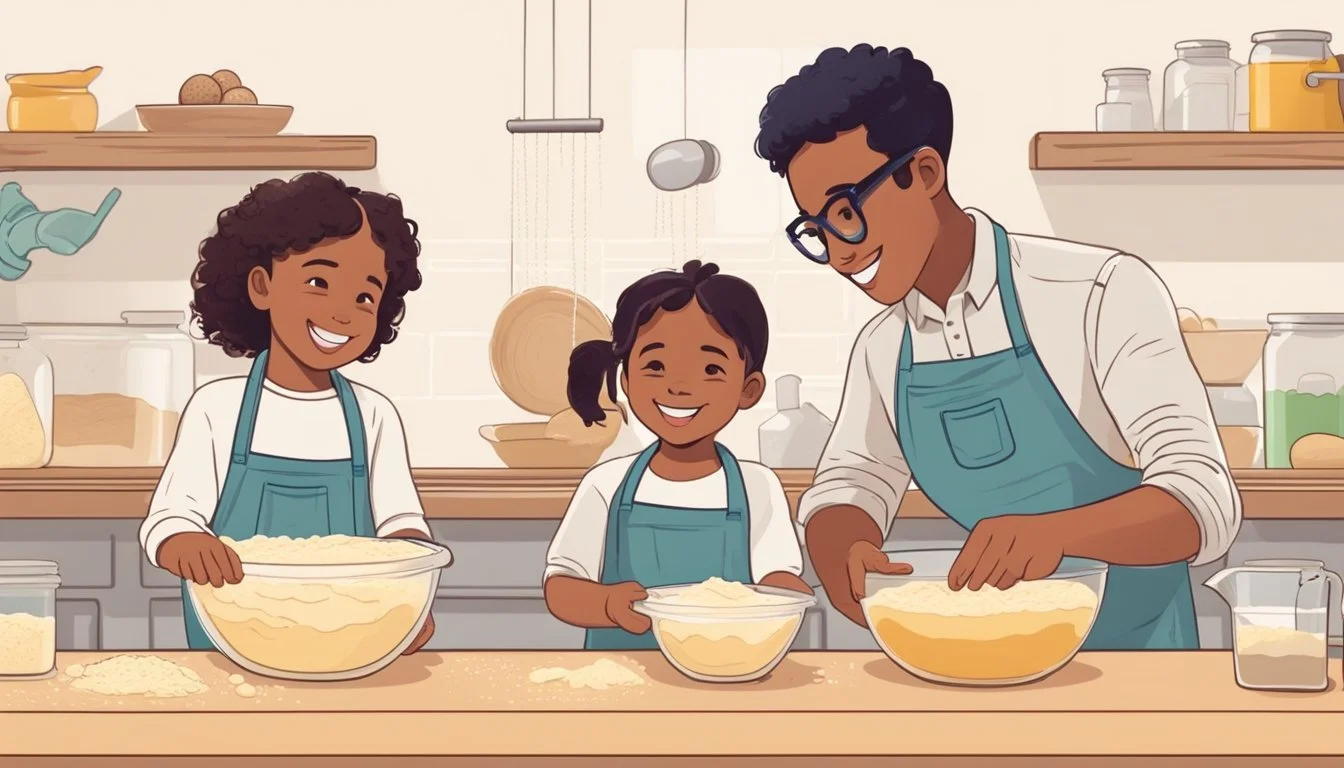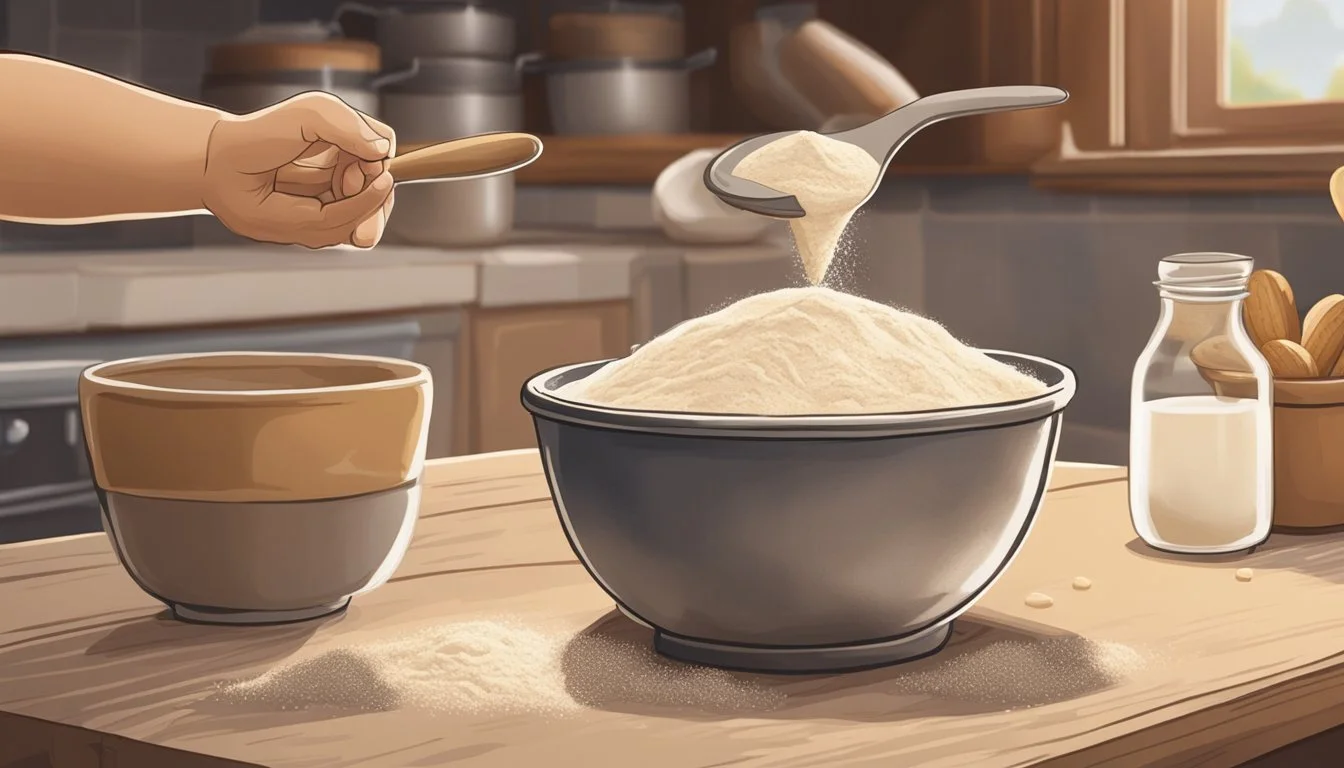Sourdough Baking with Kids
A Guide to Mixing Fun with Learning
Engaging children in sourdough baking offers a unique blend of culinary art, science learning, and family bonding. As families gather in the kitchen to mix flour, water, and salt, a simple recipe transforms into an interactive educational experience. Children learn the fascinating workings of the sourdough starter, a live culture that serves as the backbone of the bread (What wine goes well with bread?)-making process. Observing the starter come to life, children witness the tangible results of fermentation and the critical role of microorganisms in cooking.
The sourdough baking process provides various lessons that range beyond the kitchen. Young bakers acquire patience and discipline as they follow the steps from starter creation to loaf baking. Throughout the stages of sourdough preparation, kids discover the importance of measurements, timing, and the subtle changes that occur in the dough. This educative journey not only stimulates curiosity but also enhances their understanding of natural processes and the satisfaction of creating something from scratch.
In addition to the educational benefits, sourdough baking with kids is sprinkled with fun facts and creative opportunities making the entire experience enjoyable. Parents can share intriguing information about the history of bread, the science of baking, and bread's cultural significance around the world. With each new baking session, families can experiment with different ingredients, shapes, and techniques, enriching the baking experience and creating lasting memories together.
The Joy of Sourdough Baking
Sourdough baking presents a delightful activity for families, merging the art of bread making with educational opportunities. It serves to connect parents with their children in a hands-on learning environment while promoting a healthier dietary option.
Connecting with Kids Through Baking
Engaging children in sourdough baking can strengthen family bonds. Sourdough starter, the foundation of the bread, fascinates children as they observe its growth and take part in feeding it. The tangible process of mixing ingredients and shaping dough provides a shared activity that can bring enjoyment and a sense of accomplishment to both parents and children.
Sourdough Baking as Educational Fun
Baking sourdough bread introduces kids to scientific concepts such as fermentation and the role of microorganisms in food. It can transform an ordinary kitchen into a laboratory where kids learn about chemistry through measuring and mixing. The process becomes a fun, hands-on lesson, teaching patience as they await the dough to rise and resilience from the trial and error inherent in perfecting their loaves.
Healthier Choices with Homemade Bread
Sourdough bread is a healthier alternative to many store-bought varieties. Not only can families control the ingredients to avoid preservatives, but the fermentation process of sourdough can also make nutrients more available and the bread easier to digest. This direct control over what goes into their bread allows families to make better nutritional choices.
Understanding Sourdough Basics
In the world of artisan bread-making, sourdough is renowned for its distinct tangy flavor, chewy texture, and crisp crust. Essential to creating this bread is understanding its key components: the sourdough starter and the fermentation process that occurs within it.
What is Sourdough?
Sourdough refers to bread made from the natural occurring yeast and bacteria in flour. In contrast to bread made with commercial yeast, sourdough does not require store-bought yeast. Instead, it relies on a sourdough starter – a fermented mixture of flour and water – that contains wild yeast and lactobacilli to leaven the bread.
Exploring Sourdough Starter
A sourdough starter is a living culture that requires regular feeding. To create a starter, one must combine equal parts of flour and water. Over time, the mixture will attract wild yeast and bacteria from the environment, which will cause it to ferment and develop the capacity to rise dough. The maintenance of the starter involves a rhythm of feeding it with fresh flour and water, while discarding some of the old mixture.
Creating a Starter
Mix equal parts of flour and water (e.g., 100g of each).
Let sit at room temperature.
Feed daily with equal parts of flour and water.
Maintaining a Starter
Discard half the starter.
Replenish with equal parts of fresh flour and water.
Allow it to reach peak activity before using.
Science of Fermentation
The fermentation in sourdough baking is a biological process where enzymes in flour break down complex carbohydrates into simpler sugars. Yeast present in the starter metabolizes these sugars, expelling carbon dioxide gas and producing alcohol in the process. This gas gets trapped in the dough, forming the characteristic holes and giving sourdough its rise. The bacteria, mainly lactobacilli, produce lactic and acetic acid, adding to the bread's flavor and preserving qualities.
Key Scientific Points
Enzymes break down carbohydrates into sugars.
Yeast consumes sugars, producing CO2 for leavening.
Lactobacilli create acids, contributing to taste and preservation.
Through managing the starter and leveraging the science of fermentation, one can bake sourdough bread that is flavorful and uniquely satisfying.
Getting Started with Sourdough
Embarking on the sourdough journey with kids opens up a world where culinary art meets science. This starter guide will help anyone craft their first sourdough dough with the basic ingredients and steps needed for success.
Gathering the Ingredients
To kick off the sourdough baking process, one must first gather a few fundamental components. The table below outlines the key ingredients necessary for creating a sourdough starter—the foundation of any sourdough bread:
Ingredient Purpose Flour Provides the starches needed for the fermentation process. Whole grain flours are preferred for their nutrient content and fermentability. Water Hydrates the flour and activates the natural yeast and bacteria in the sourdough starter.
It is crucial for these ingredients to be of high quality because they directly affect the flavor and texture of the bread.
Making Your First Dough
After the sourdough starter is active, one can proceed to make their first dough. The process involves mixing the starter with additional flour and water to form the dough. Here's a simplified breakdown:
Combine a portion of the sourdough starter with water and mix until well-integrated.
Gradually add flour to the starter mixture, integrating it until the dough begins to form.
Once the dough has taken shape, it should be kneaded until smooth and elastic, a sign that the gluten structure has developed sufficiently.
This initial dough-making venture serves as a hands-on lesson for kids, illustrating the transformation of simple ingredients into something new and exciting through the traditional methods of sourdough baking.
Baking with Kids: Tips and Techniques
When introducing sourdough baking to kids, it's crucial to focus on safety, precise measurement, and the tactile experience of mixing and kneading. Parents and educators can guide children through the process, ensuring that they learn valuable skills while enjoying the craft of baking.
Safety and Supervision in the Kitchen
When baking with children, safety is of the utmost importance. Parents should ensure that kids understand kitchen hazards such as hot surfaces, pointy implements, and electrical equipment. Teach them to:
Always wash their hands before and after handling food.
Never touch appliances without permission.
Wear appropriate attire, avoiding loose sleeves or jewelry.
It's essential that an adult is always present to supervise and prevent accidents.
Teaching Measurement and Consistency
Correct measurement is foundational in baking, as consistency can make or break a sourdough loaf. Use these opportunities to teach children how to:
Use measuring cups and spoons for dry and liquid ingredients.
Level off a cup of flour with a straightedge for accuracy.
Understand the importance of following a recipe correctly.
Explain that baking is a science, and precise measurements lead to consistent and delicious results.
Hands-on Experience: Mixing and Kneading
Mixing and kneading dough are engaging hands-on techniques for kids. Parents can guide them through:
The proper way to combine ingredients without overmixing.
The technique of kneading dough to develop gluten, explaining its role in the bread's texture.
The feel of dough at different stages of development.
Encouraging kids to get their hands dirty and experience the transformation of the dough can be an educational and enjoyable process.
Sourdough Recipes and Activities
This section offers a selection of sourdough recipes and activities that are perfect for engaging children in the baking process. Each activity is centered around the foundational skills of sourdough bread making, incorporating different aspects to explore its versatility.
Classic Sourdough Loaf
The classic sourdough loaf is the cornerstone of sourdough baking. It requires a sourdough starter, which is a fermented mixture of flour and water. For families beginning their baking journey, a simple recipe for an easy same-day sourdough loaf involves the basic techniques of mixing, shaping, and scoring.
Ingredients: Flour, water, salt, and active sourdough starter.
Key Steps:
Combine ingredients and mix until well-incorporated.
Allow the dough to rise.
Shape the dough into a loaf.
Score the top to control where the bread expands when baked.
Bake until golden-brown and crisp.
Creative Uses for Sourdough Discard
Sourdough discard, the portion of sourdough starter that is removed before feeding, can be repurposed into a variety of recipes instead of being wasted. English muffins and chocolate chip cookies are excellent examples of how to turn discard into delicious treats.
English Muffins:
Mix discard with milk, sugar, and flour.
Cook on a griddle until browned on both sides.
Chocolate Chip Cookies:
Add discard to the traditional cookie recipe for an extra tangy flavor.
Bake until the edges are crisp and the centers are slightly soft.
Sweet and Savory Variations
Children can expand their baking skills by exploring both sweet and savory variations of sourdough bread. Chocolate cherry brownies and sweet s’more sourdough loaf are unique twists that provide an enjoyable challenge and allow kids to experience the diverse possibilities of sourdough baking.
Chocolate Cherry Brownies:
Combine sourdough discard with cocoa powder, cherries (how long do cherries last?), and chocolate chunks.
Bake until set for a gooey, chocolatey dessert.
Sweet S’more Sourdough Loaf:
Incorporate graham cracker pieces, chocolate, and marshmallows into the dough.
Bake to create a loaf that captures the essence of the classic campfire treat.
By engaging with these recipes and activities, children not only learn valuable cooking and baking skills but also benefit from the science and creativity involved in the art of sourdough baking.
Observation and Learning
Through observation and learning, children can gain invaluable insights into the scientific and cultural aspects of sourdough baking. They witness physical changes and learn about the biological entities involved, providing them with a hands-on educational experience.
Watching Dough Rise and Fall
Kids can physically observe the sourdough's rise and fall, which serves as a visual demonstration of the fermentation process. They learn that as the dough increases in volume, it's a sign of the yeast's activity. Watching the dough can be a lesson in patience and the importance of time in cooking.
Rise: Charting the dough's expansion
Fall: Noting how the dough deflates after proofing
Learning About Microorganisms
The sourdough starter is alive with microorganisms, and children discover how these tiny organisms create bubbles and cause the dough to rise. They learn about the yeast and bacteria that are key components in the sourdough bread-making process.
Yeast & Bacteria: Introduction to the roles of different microorganisms.
Baking as a Window to the World
Sourdough baking offers a glimpse into a variety of cultures, connecting children to the world through food. They can explore different sourdough recipes from around the globe, learning about the diverse ways bread is integrated into daily life.
Breadcrumbs: Tracing the cultural significance of bread in various societies.
Changes: Identifying the influence of different ingredients and techniques on the sourdough process.
The Values Baked into Sourdough
Sourdough baking is not just a culinary activity; it's a rich experience that teaches valuable life lessons to both children and adults. Through the process of baking sourdough bread, families can cultivate patience, instill discipline, and create long-lasting memories and traditions.
Patience and Discipline in Baking
The process of baking sourdough bread requires patience — from nurturing the starter to waiting for the dough to rise. It's an excellent lesson for children who learn the significance of waiting for something rewarding. They'll observe how the starter transforms over days, which teaches them the natural progression of growth and development.
Discipline comes into play through the methodical steps required in sourdough baking. Families must follow a routine to feed the starter, measure ingredients precisely, and maintain the optimum conditions for the dough to ferment and rise. This consistency fosters an understanding of the importance of routine and adherence to a process to achieve the desired result.
Creating Memories and Traditions
Sourdough baking is a memorable activity that families can bond over. The simple act of measuring ingredients, mixing them, and shaping the dough becomes a cherished routine. These shared experiences often develop into traditions passed down through generations, strengthening family ties and creating a sense of belonging and continuity.
Moreover, the final product — a freshly baked loaf of sourdough — is a tangible achievement that the family can take pride in and enjoy together. Each loaf serves as a delicious reminder of the time spent together and the skills developed during the process.
Troubleshooting and Perfecting Techniques
In the world of sourdough baking with kids, it's important to address challenges and understand how to achieve the perfect crust and crumb. This guidance helps child bakers learn the precise balance of ingredients and conditions for successful sourdough loaves.
Dealing with Common Sourdough Challenges
Baking sourdough bread is a rewarding but sometimes tricky process, where numerous variables can affect the outcome. One common issue involves the fermentation process, which can be too slow or too fast. Bacteria and yeast are responsible for fermentation, and they require the right conditions to produce the necessary carbon dioxide. If a loaf does not rise sufficiently, it may be due to a lack of warmth or vitality in the starter.
To address this:
Temperature: Ensure the dough is kept in a warm, draft-free environment.
Starter Vigor: The starter should be bubbly and active; if not, consider feeding it more often.
Another issue arises with the addition of warm water and salt to the sourdough mixture. Warm water is vital to activate the yeast, but too hot can kill the yeast, and too cold can retard its activity. Meanwhile, salt strengthens the gluten structure, but too much can inhibit yeast growth and impede fermentation.
They should:
Test Water Temperature: Aim for lukewarm water, typically between 105°F (40°C) and 115°F (46°C).
Measure Salt Accurately: Follow recipes closely to avoid over- or under-salting.
Achieving the Perfect Crust and Crumb
The crust and crumb of a sourdough loaf are telltale signs of its quality. Aspiring young bakers strive for a crust that is crispy and a crumb that is airy with even holes. The perfect crust is achieved primarily through steam during the initial phase of baking and the right amount of browning thereafter.
To achieve this:
Steam: Create steam in the oven by using a baking stone and a tray of water or employing a Dutch oven.
Browning: Monitor the bread during the final stage of baking to ensure it browns evenly without burning.
For the crumb to develop properly, the gluten network must be strong and the gas retention high. Kneading techniques play a crucial role in developing gluten.
They should focus on:
Kneading: Encourage a thorough but gentle kneading process to form a strong gluten network.
Proofing: Allow the bread sufficient time to proof, ensuring the yeast produces enough carbon dioxide to create a well-aerated crumb.
Concluding, through methodical troubleshooting and refining techniques, both children and adults can find joy and success in the art of sourdough baking.







